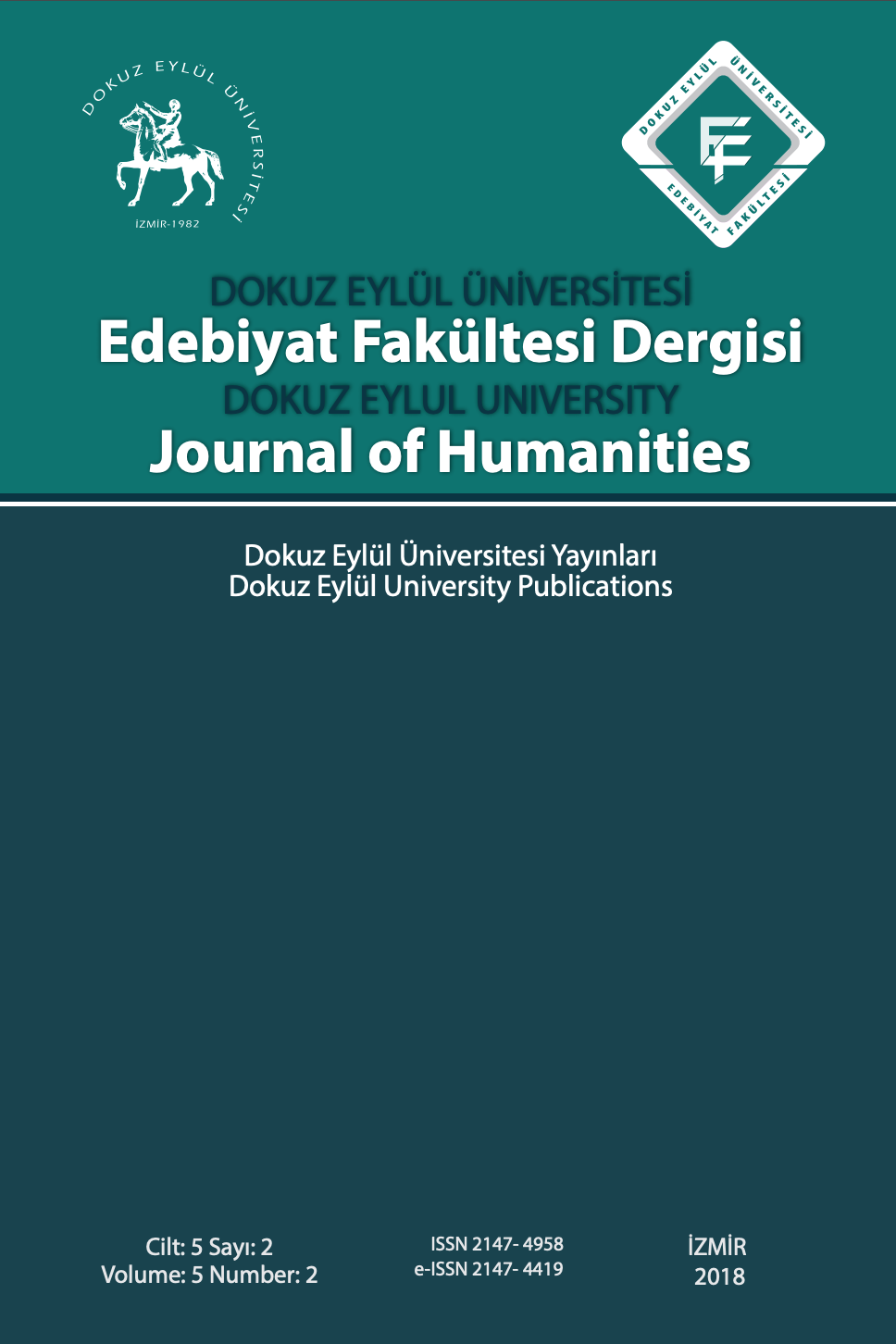MUGBY JUNCTION'DA DEMİRYOLLARI VE DEMİRYOLU ÇALIŞANLARI
Viktorya dönemi demiryolları, demiryolu çalışanları, Mugby Junction, gizem, demiryolu hikayeleri
RAILWAYS AND RAILWAYMEN IN MUGBY JUNCTION
Victorian railways, railwaymen, Mugby Junction, mystery, railway stories,
___
- Armstrong, T. (2000). Haunted Hardy: Poetry, history, memory. England: Palgrave.
- Beaumont, M. & Freeman, M. (Eds.). (2007). The railway and modernity: Time, space, and the machine ensemble. Bern: Peter Land AG, International Academic Publishers.
- Berman, M. (1983). All that is solid melts into air: The experience of modernity. London: Verso.
- Carter, I. (2001). Railways and culture in Britain: The epitome of modernity. Manchester: Manchester UP.
- Daly, N. (2004). Literature, technology and modernity 1860-2000. Cambridge: Cambridge UP.
- Dickens, C. (1982 [1846-48]). Dombey and son. Oxford: Oxford UP.
- Dickens, C. (2010 [1866]). No.1. branch line. The signalman. In Charles Dickens (Ed.) Mugby junction. In All the year round. Retrieved from 20 October, 2010. British Periodicals http://britishperiodicals.chadwyck.co.uk/marketing/index.jsp pp. 20-25.
- Edwards, A. (2010 [1866]). The engineer. In Charles Dickens (Ed.) Mugby junction, All the year round. Retrieved from 20 October, 2010. British Periodicals http://britishperiodicals.chadwyck.co.uk/marketing/index.jsp pp. 42-48.
- Freeman, M.J. (1999). Railways and the Victorian imagination. New Haven: Yale UP.
- Gavin, A. E. & Humphries A. F. (Eds.). (2015). Introduction. In The transports of fiction: Technologies of movement, 1840-1940. Basingstoke.
- Gilmour, R. (1993). The Victorian period: The intellectual and cultural context of English iterature 1830-1890. New York: Longman.
- Halliday, A. (2010 [1866]). The engine-driver. In Charles Dickens (Ed.) Mugby Junction. In All the year round. Retrieved from 20 October, 2010. British Periodicals http://britishperiodicals.chadwyck.co.uk/marketing/index.jsp pp. 25-28.
- Harputlu, Z. (2016). Sprectrality and abjection in the stories of Charles Dickens’ ‘The Signal-man’ and Herman Melville’s ‘Bartleby’. Cumhuriyet University, Journal of Social Sciences, 40 (1), 203-213.
- Hayes, C.J.H. (1941). A generation of materialism, 1871-1900. New York: Harper and Brothers.
- Joby, R.S. (1984). The railwaymen. Newton: David and Charles.
- Kern, S. (1983). The culture of time and space, 1880-1918. Cambridge: Harvard UP.
- Kingsford, P.W. (1970). Victorian railwaymen: The emergence and growth of railway labour, 1830- 1870. London: Frank Cass.
- Landow, G. (2010 [2009]). Railways and Victorian literature. The Victorian Web. Retrieved 22 June, 2010. http://victorianweb.org/technology/railways/rrlit1.html
- Leech, J. (2018 [1845]). The Railway Juggernaut. Cartoon from Punch, London. Retrieved 12 March 2018.http://www.digitalvictorianist.com/2013/04/the- pleasures-of-print-2-this-time-its- personal/
- Martin, D. (2017). Affirmative signalling: Dickens’s railway journalism and Victorian risk society. Journal of Victorian Culture, 22 (4), 427-449. doi:10.1080/13555502.2017.1353434
- Matus, J. L. (2001). Trauma, Memory, and Railway Disaster: A Dickensian Connection. Victorian Studies, 43 (3), 413–436.
- Mckay, J.P., Hill, B.D. & Buckler, J. (Eds.). (1991). A history of western society. Boston: Houghton Miffin.
- Mitchell, B.R. (1975). European historical statistics, 1750-1970. Macmillan.
- Robbins, M. (1998). The railway age. 1962. Manchester: Manchester UP.
- Railway workers [Online image]. (2018 [2012]). Hayes Peoples History. Retrieved 18 March 2018. http://ourhistory- hayes.blogspot.com.tr/2012/01/amalgamated-society-of-railway-servants.html?m=1
- Schivelbusch, W. (1986 [1977]). The railway journey: The industrialization of time and space in the nineteenth century. New York: Berg Publishers.
- Schwarzbach, F.S. (1979). Dickens and the city. London: Athlone Press.
- Shuttleworth, S. & Taylor, J.B. (Eds.). (1998). Embodied selves: An anthology of psychological texts, 1830-1890. Oxford: Clarendon Press.
- Simmel, G. (1950). The metropolis and mental life. In Kurt H. Wolf (Ed.), The Sociology of Georg Simmel. New York: Free Press.
- Simmons, J. (1991). The Victorian railway. Slovenia: Thomes and Hudson.
- Slater, P. W. (2016 [1866]). The ghost in the machine ensemble: Generating the industriall supernatural in ‘Mugby junction’. Retrieved 10 June, 2016. https://playgroundsinprison.wordpress.com/2014/11/24/the-ghost-in-the- machine- ensemble-generating-the-industrial-supernatural-in-mugby- junction-1866/amp/ Steam Locomotive with Engine Driver and Stoker [Online image]. (2018). Retrieved from Victorian Picture Library. http://www.victorianpicturelibrary.com/downloads/steam-locomotive- with- engine-driver-and- stoker/
- Stretton, H. (2010 [1866]). The travelling post-office. In Charles Dickens (Ed.) Mugby junction. In All the year round. Retrieved from 20 October, 2010. British Periodicals http://britishperiodicals.chadwyck.co.uk/marketing/index.jsp pp.35-42
- Traveling Post-office [Online image]. (2014). The British Postal Museum and Archive. 2014. Retrieved from https://postalheritage.wordpress.com/tag/tpo
- ISSN: 2147-4958
- Yayın Aralığı: 2
- Başlangıç: 2011
- Yayıncı: Dokuz Eylul Üniversitesi Matbası
Söylem, Söylem Çözümlemesi ve Eleştirel Söylem Çözümlemesi: Tanımları ve Kapsamları.
Gülsüm Songül ERCAN, Pınar DANIŞ
MUGBY JUNCTION'DA DEMİRYOLLARI VE DEMİRYOLU ÇALIŞANLARI
THALES VE ANAKSİMENES’İN GÜNÜMÜZDE UNUTULMUŞ ELEMENTLERİ: SU VE HAVA
OSMANLI DEVLETİ İLE KAZAK HANLIĞI ARASINDAKİ SİYASİ İLİŞKİLER (XVIII. yy)
HASAN BOĞULDU ÖYKÜSÜ’NÜN GÖSTERGEBİLİM KİPLİKLERİ AÇISINDAN İNCELENMESİ
GESTALT BAKIŞ AÇISIYLA EDEBİYAT ELEŞTİRİSİ - BİR UYGULAMA: SERVİ, SABAHATTİN ALİ
İNGİLİZ VE HİNT EDEBİYATLARINDA GOTİK: OTRANTO ŞATOSU VE VETĀLAPAÑÇAVİṂŞATİ
JAPONCA VE TÜRKÇEDEKİ HAYRET İFADELERİ ÜZERİNE
KAFKA’NIN “BİR KÖY DOKTORU” HİKÂYESİNDE TEKİNSİZ EVLER VE EVSİZLİK
